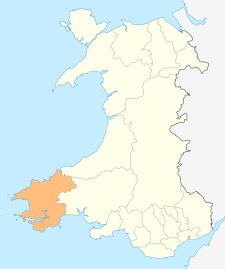St Davids
St Davids or St David's[2][3] (Welsh: Tyddewi, [tɨː ˈðɛwi], lit. "David's house") is a city[4] and a community (named St Davids and the Cathedral Close)[5] with a cathedral in Pembrokeshire, Wales, lying on the River Alun. It is the resting place of Saint David, Wales's patron saint, and named after him. St Davids is the United Kingdom's smallest city in terms of population (1,841 in 2011)[6] and urban area. (The smallest city by local authority boundary area is the City of London.) St Davids was given city status in the 12th century. This does not derive automatically from particular criteria, although in England and Wales it was traditionally given to cathedral towns under a practice laid down in the early 1540s, when King Henry VIII founded dioceses. City status was lost in 1886, but at the request of Queen Elizabeth II restored in 1994.

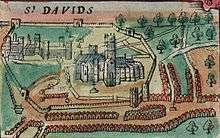

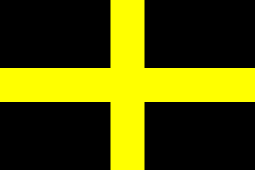
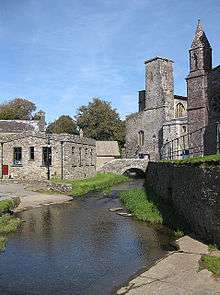
St Davids
| |
|---|---|
| City | |
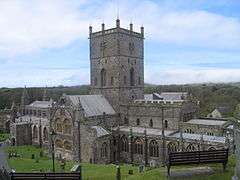 St Davids Cathedral | |
 St Davids Location within Pembrokeshire | |
| Area | 17.93 sq mi (46.4 km2) (community) 0.23 sq mi (0.60 km2) (urban area) |
| Population | 1,841 [1] (2011) |
| • Density | 103/sq mi (40/km2) |
| OS grid reference | SM755255 |
| Community |
|
| Principal area | |
| Ceremonial county | |
| Country | Wales |
| Sovereign state | United Kingdom |
| Post town | HAVERFORDWEST |
| Postcode district | SA62 |
| Dialling code | 01437 |
| Police | Dyfed-Powys |
| Fire | Mid and West Wales |
| Ambulance | Welsh |
| UK Parliament | |
| Senedd Cymru – Welsh Parliament |
|
History
Tradition states that David was born to Saint Non at what is now St Non's, just to the south of the city, in about AD 500. It is said that he was baptised at Porthclais, now the city's port, and was brought up by his mother at Llanon. St David may also have been educated at Ty Gwyn, Whitesands, by St Paulinus.
In the 6th century, David founded a monastery and church at Glyn Rhosyn (Rose Vale) on the banks of the River Alun. The area was originally known in the Welsh language as Mynyw and to the Romans as Meneva or Menevia. The monastic brotherhood that David founded was very strict — besides praying and celebrating masses, they cultivated the land and carried out many crafts, including beekeeping, in order to feed themselves and the many pilgrims and travellers who needed lodgings. They also fed and clothed the poor and needy.[7]
The settlement that grew up around the monastery was called Tyddewi meaning "David's house". In 519 the archbishopric of Caerleon in the county of Monmouth was transferred to Mynyw, which was renamed "St Davids" in honour of the archbishop and saint by whom the transfer was accomplished.[8] The original cathedral built on the site was often plundered by the Vikings and was finally burnt and destroyed in 1087. The present cathedral was built by the Normans and contained many relics, including the remains of St David. It was visited by many pilgrims, many of whom were nobles and kings, including William the Conqueror in 1077, Henry II in 1171, and Edward I and Queen Eleanor in 1284.[8] Pope Calixtus II decreed that two pilgrimages to St Davids were equivalent to one to Rome ("Roma semel quantum dat bis Menevia tantum"). Because of this, a vast income was raised from visiting pilgrims in the Middle Ages.[9] Pilgrimages later fell out of favour due to practices such as the selling of indulgences, and the income from them faded away. By the 19th century, the city of St Davids was isolated and neglected and was described in the Penny Cyclopaedia,[8]
At present its appearance is that of a poor village, the houses, excepting those of the clergy, being in a ruinous state. The locality is lonely, and the neighbouring district wild and unimproved; but it is still an interesting place as the seat of a large episcopal see, with a fine cathedral and the remains of other magnificent religious edifices.
Since then, better transport and the advent of tourism have helped the city prosper again. Next to the cathedral, the 13th-century Bishop's Palace is a ruin maintained by Cadw and open to visitors. The city was once a marcher borough, within which lay the hundred of Dewisland. In 1603, the antiquarian George Owen described it as one of five Pembrokeshire boroughs overseen by a portreeve.[10]
Geography
The community council area sits at the southern end of the Irish Sea on a peninsula, between Cardigan Bay, St George's Channel and St Brides Bay. It covers not just the mainland area, but also several islands off the coast, of which Ramsey Island is the largest and the only one inhabited, separated by the Ramsey Sound. The most westerly mainland point of Wales is at Pen Dal-aderyn. To the north lie Whitesands Bay and St Davids Head, which are locally notable landscape features. The mainland contains much area used for farming, but contains very small scattered residences and several campsites. St Davids Lifeboat Station, at St Justinian, has saved an estimated 360 people since the first lifeboat was located there in 1869; four lifeboatmen have died while saving others.[11] The Irish Sea includes a large number of offshore rocks and islands and is notorious for strong tides.[12] The entire coastline around St Davids forms part of the Pembrokeshire Coast National Park. Saint Non's Well overlooks the Pembrokeshire Coast Path and St Brides Bay. St David's Airfield, although named after the city when opened in 1943,[13] is in the neighbouring community of Solva. The highest point is Carn Llidi at 181 metres (594 ft).
There are several isolated hamlets in the community:
- Berea
- Caerfarchell
- Carnhedryn
- Fachelich/Vachelich[14]
- Llandruidion
- Rhodiad-y-brenin
- Treleddyd-fawr
- Trelerw
- Tretio
Several islands and islets lie within a few miles from the coast. These are administratively within St Davids:
- Ramsey Island, also known as Ynys Dewi, is the largest.
- Carreg Yr Esgob
- Carreg Fran
- Ynys Eilun
- Ynys Bery
The islands below are part of the Bishop And Clerks grouping, and were included in 1987:[15]
- Carreg Rhoson
- Carreg Rhoson East Island
- Carreg-trai
- Cribog
- Daufraich
- Llechau-isaf
- Llechau-uchaf
- Maen Daufraich
- Maen Rhoson
- Moelyn
- North Bishop
- South Bishop also known as Em-sger, is the furthest away from Pen Dal-aderyn at 4 miles.
City status
In the 16th century a town was recognised as a city by the English Crown if it had a diocesan cathedral within its limits along with a royal charter or borough privileges, but this link was abolished in 1888,[16] and amid prior borough reorganisation (see Governance below),[17] St Davids lost the right to call itself a city. In 1991 St Davids town council proposed that a case for city status, which the residents had long considered it to have anyway, should be promoted in connection with the 40th anniversary of the coronation of Queen Elizabeth II, and in 1992 the Home Office agreed to refer the matter to Buckingham Palace. In 1994, at the Queen's request, St Davids was again granted city status along with the Northern Irish town of Armagh, "in recognition of their important Christian heritage and their status as cities in the last century".[16] The letters patent conferring city status were formally presented by the Queen in a ceremony at St Davids Cathedral on 1 June 1995.[18]
The award of city status is typically granted to a local authority,[19] whose administrative area is then considered to be the formal borders of the city. By this definition, the whole community area of St Davids and the Cathedral Close, including the settlement of St Davids, its surrounding rural area, and islands off the coast, is considered to be the limits of the city. St Davids contains the lowest population of all the cities of the UK, and has the smallest urban area, at 0.23 sq mi (0.60 km2). However, with the formal city area defined by its community council extent of 17.93 sq mi (46.4 km2), this sizeable expanse including offshore islands does mean that several UK cities are physically smaller, with the City of London being the smallest at 1.12 sq mi (2.9 km2). In Wales, St Davids is the third smallest after the community areas of St Asaph with 2.49 sq mi (6.4 km2) and Bangor with 2.79 sq mi (7.2 km2).
Governance
St Davids became a borough from 1115,[20] when Bernard, the first Norman Bishop of St Davids was granted a charter by Henry I which designated the lands of Dewisland as a Marcher Lordship.[21]
This gave the Bishop wide-reaching powers over this realm, with his headquarters remaining initially at St Davids. However, into the Middle Ages subsequent Marcher Bishops came to base the administration of Dewisland including the exchequer, chancery and court to Llawhaden by the 13th century.[22][23] King Henry VIII then passed the Laws in Wales Acts, these in 1535 and 1542 abolished the status of Marcher Lordships; Dewisland was merged with the adjacent Lordship of Kemes and the surrounding Lordship of Pembroke to form Pembrokeshire, of which Dewisland then became a hundred. In 1835 a report from government commissioners investigating municipal corporations determined that:
THE city and parish of St. David's is situate in the manor of Dewisland. The Bishop of St. David's is Lord of the Manor; and it appears that an officer, called the Mayor, is annually appointed by the steward, whose duty is to collect certain chief rents to the bishop. The mayor assumes to take certain small tolls by virtue of his office: his right to do this is disputed, but the tolls being very trifling, are frequently paid. The mayor is merely an officer of the Manor Court. A belief exists amongst some of the inhabitants that the city was once a corporation; but there are no burgesses, charter, or other vestige of municipal institutions. The belief has probably arisen from the lord's officer being called a mayor.[24][25]
Due to this summarisation, the borough was considered within the report as 'municipal in name only', and non-parliamentary.[26] Any remaining legalities pertaining to the city were removed in 1886, when these were abolished by the Municipal Corporations Act 1883, with its corporation deemed to be long extinct, and a very small population (1,025 residents in 1835)[26] not helping its cause in an age where boroughs with unrepresentative populations were being singled out for reform. This act, in turn, appears to have caused the loss of city status, as there was no corporate body available to petition for a renewal of its charter.[17]. The subsequent renewal of the status in 1995 (see City Status above) and reasons then given conclude the status was in place until 1886.
The borough lay across two parishes, and by the time of the creation of registration districts in 1837 these were:[27][28]
- Cathedral Close of St. David's – the close surrounding the cathedral and associated church buildings;
- St Davids – the rest of the city and rural areas.
These were split from the church into civil parishes during 1866, electing secular councillors from 1895, converted to Welsh community administrative areas in 1974, and merged in 1987[5] to form the present day St Davids and the Cathedral Close.
St Davids City Council is the community council body, and is composed of twelve councillors.[29] The City Council employs one City Clerk and one Financial Officer.[29] In June 2020 the council elected its first Sikh mayor, Councillor Bira Sehmi, believed also to be the first Sikh mayor in Wales.[30]
The parishes were part of the Haverfordwest rural sanitary district, then Haverfordwest rural district from 1894 until 1974, when they were changed into communities and placed into Preseli district.[31] Preseli was abolished in 1996 under further local government reform, and the city presently comes under Pembrokeshire County Council for all principal government services.
The electoral ward of St Davids elects a county councillor to Pembrokeshire County Council.
Culture
Arts
The city hosted the National Eisteddfod in 2002. The Archbishop-designate of Canterbury, Dr Rowan Williams, was inducted into the Gorsedd of Bards, a historic order of Druids.[32]
Charity
The St Davids Penknife Club is a group of people dedicated to voluntary fund raising for local groups and charities.[33]
Sport
St Davids has a rugby union club, St. Davids RFC, which competes in the Welsh Rugby Union League West.[34]
Tourism
In addition to the cathedral, notable features of the city include the 14th-century Tower Gate, the Celtic Old Cross and a number of art galleries. St Davids is also a base for walking and water sports. It has several hotels, a pharmacy, shops and galleries, a youth hostel and a number of pubs. In 2019 Consumers' Association members placed St Davids in the top three best value beach destinations in Britain.[35] Whitesands Bay, about two miles west of St Davids, is a popular water sports resort. It has been described as the best surfing beach in Pembrokeshire and among the best tourist beaches in the world.[36]
Education
Ysgol Dewi Sant (St David's School) is the local secondary school, with pupils in Years 7–13 (i.e. aged from 11 to 18).[37] Ysgol Bro Dewi (Dewisland School) is a Voluntary Controlled Primary School, with pupils from Reception to Year 6.
Notable people
The following were born in St Davids:
- Asser (died c. 909), a monk at St Davids who was mentor to King Alfred the Great, and writer of his biography[38]
- William Barlow (died 1625), an expert on magnetism and Anglican cleric whose father, also William Barlow, served as bishop in 1536–1548.[39]
- Kieran Evans (born 1969), a film director and screenwriter[40]
- Wilfrith Green (1872–1937), a brigadier-general who served in the British and Indian armies
- Henry Hicks (1837–1899), a surgeon and geologist who practised there from 1862 until 1871[41]
- Jasmine Joyce (born 1995), a rugby union player who played for Wales women's national rugby sevens, and for the British women's sevens team at the 2016 Summer Olympics[42]
- Rowland Phillips (born 1965), a rugby union player who played for Wales, and later rugby league for Wales and for Great Britain
- Thomas Tomkins (1572–1656), a musician and composer[43]
- Ian Walsh (born 1958), a Wales national association football player
Twin towns
St Davids is twinned with: [44]
See also
References
- Office for National Statistics Archived 2 April 2015 at the Wayback Machine 2011 census – St David's and the Cathedral Close C
- Parish Headcounts for Pembrokeshire Archived 10 September 2012 at the Wayback Machine (based on 2001 Census) at Office for National Statistics. Retrieved 2011-08-01
- As specified in New Oxford Dictionary for Writers and Editors OUP 2005. The name is often spelt without its possessive apostrophe, including by the St Davids City Council Archived 1 December 2005 at the Wayback Machine
- "GENUKI: St David's". Archived from the original on 10 March 2016. Retrieved 7 March 2016.
- "The Preseli (Communities) Order 1987". www.legislation.gov.uk. Archived from the original on 10 September 2018. Retrieved 9 September 2018.
Communities 6. In the District as altered....
(3) the... existing communities of ...Cathedral Close of St. David's, ...St. Davids, ...shall be abolished;
(4) ...new communities to be known as ...St. Davids and the Cathedral Close, ...shall be constituted; - "Office for National Statistics 2011 – census – St David's and the Cathedral Close C". Archived from the original on 2 April 2015. Retrieved 13 March 2015.
- Jones, Rhys James (28 February 1994). "Saint David and Saint David's Day". Archived from the original on 7 June 2012. Retrieved 21 June 2012.
- Anon (1837). "David's, St". The Penny Cyclopædia of the Society for the Diffusion of Useful Knowledge. London: Charles Knight and Co. 7–8: 317. Retrieved 21 June 2012.
- St David's day, Pembrokeshire Archived 2011-09-27 at the Wayback Machine at History.UK.com, 16 February 2003. Retrieved on 1 August 2011
- George Owen, The Description of Penbrokshire by George Owen of Henllys Lord of Kemes, Henry Owen, ed., London, 1892.
- St Davids Lifeboat Station: Introduction Archived 2011-08-11 at the Wayback Machine at Royal National Lifeboat Institution (RNLI). Accessed 1 August 2011.
- St Davids Lifeboat Station Archived 2011-08-22 at the Wayback Machine at Royal National Lifeboat Institution (RNLI). Accessed 1 August 2011.
- "Dyfed Archaeological Trust: St David's Airfield". Retrieved 18 June 2020.
- "RCAHMW: Historic place names: Vachelich". Retrieved 18 June 2020.
- "The Preseli (Communities) Order 1987". www.legislation.gov.uk. Archived from the original on 10 September 2018. Retrieved 9 September 2018.
Communities (6) the Bishops and Clerks shall be included in the new community of St. Davids and the Cathedral Close
- Beckett, J. V. (2005). City status in the British Isles, 1830–2002. Ashgate Publishing, Ltd. p. 22. ISBN 9780754650676. Retrieved 31 January 2012.
- "Agenda Item No: 5 COMMITTEE REGENERATION AND COMMUNITY OVERVIEW AND SCRUTINY COMMITTEE DATE 4 MARCH 2003 TITLE OF REPORT ROCHESTER CITY STATUS RESPONSIBLE OFFICER Mark Bowen, Assistant Director, Legal and Contract Services" (PDF). democracy.medway.gov.uk. Medway Council. Archived (PDF) from the original on 19 August 2016. Retrieved 22 November 2019.
St. David's in Wales lost City Status through local government re-organisation at the end of the 19th century
- Alderson, Alf (3 March 2001). "The small city with the big kicks". The Guardian. Guardian News and Media Limited. Archived from the original on 4 February 2014. Retrieved 21 June 2012.
- "Corby City Bid" (PDF). www.corby.gov.uk. Corby Borough Council.
Applications may only be made by an elected local authority – normally, in respect of the entire local authority area.
- "PROPOSED DEVELOPMENT SITE NUN STREET, ST DAVIDS, PEMBROKESHIRE: HISTORIC ENVIRONMENT APPRAISAL" (PDF). www.haystonplanning.co.uk. Archived (PDF) from the original on 8 September 2018. Retrieved 8 September 2018.
Nothing is known of any civilian settlement prior to 1115 when St Davids was established as a borough, receiving its first charter from King Henry I.
- Judgement in Crown Estate Commissioners v (1) Mark Andrew Tudor Roberts (2) Trelleck Estate Ltd: ChD (Mr Justice Lewison), 13 June 2008
- Brian Howells, Pembrokeshire County History, Volume 2, Haverfordwest, 2002, p. 148
- Judgement in Crown Estate Commissioners v (1) Mark Andrew Tudor Roberts (2) Trelleck Estate Ltd: ChD (Mr Justice Lewison), 13 June 2008
- Report on City of St Davids. First report of the commissioners appointed to inquire into the municipal corporations in England and Wales. p. 358.
- "St Davids Genealogy Resources & Parish Registers | Pembrokeshire". forebears.io.
The city [St Davids] is not incorporated, but there is an officer called a mayor or bailiff of court leet, whose duties consist only in collecting the chief rents belonging to the Ecclesiastical Commissioners within the limits of the city, which is co-extensive with the township or division called “Cylch-y-Dref,” and to see that no encroachments are made on a common which the inhabitants hold under an old lease from the bishop and chapter; he is therefore merely an officer of the manor court, and the existing belief that the city was once a corporation appears to rest on no trustworthy authority, since "there are no burgesses, charter, or other vestige of municipal institutions."
- Appendix - Table 2 - Boroughs - Municipal not parliamentary (30 March 1835). First Report of the Commissioners Appointed to Inquire Into the Municipal Corporations In England And Wales. London: C. Knight, 183540. p. 58.
- "Archived copy" (PDF). Archived (PDF) from the original on 8 September 2018. Retrieved 8 September 2018.CS1 maint: archived copy as title (link)
- "Haverfordwest Registration District". Archived from the original on 8 September 2018. Retrieved 8 September 2018.
- http://www.stdavids.gov.uk/council-information/
- "Cllr Bira Sehmi elected first Sikh mayor of St Davids and possibly all of Wales". Tivy-side Advertiser. 4 June 2020. Retrieved 19 June 2020.
- "Haverfordwest RSD through time | Census tables with data for the Sanitary District". www.visionofbritain.org.uk. Archived from the original on 10 September 2018. Retrieved 9 September 2018.
- St Davids and St Davids Cathedral, Pembrokeshire Archived 7 September 2011 at the Wayback Machine at Wales in Style. Accessed on 1 August 2011
- "St Davids Penknife Club". Retrieved 3 July 2011.
- SWALEC League Six West Archived 18 March 2014 at the Wayback Machine at Welsh Rugby Union
- "Best value British beach towns". Consumers Association. Archived from the original on 22 August 2019. Retrieved 24 August 2019.
- "Pembrokeshire County Council". 19 September 2017. Archived from the original on 20 July 2011. Retrieved 2 August 2011.
- "The Curriculum". Ysgol Dewi Sant website. 2014. Archived from the original on 16 January 2014. Retrieved 15 January 2014.
- A'Becket, John Joseph (1907). . In Herbermann, Charles (ed.). Catholic Encyclopedia. 1. New York: Robert Appleton Company.
- Joseph Foster, ed. (1891). "Baal-Barrow". British History Online. Oxford: Alumni Oxonienses 1500-1714. pp. 51–78. Retrieved 28 January 2020.
- "Bafta win for Pembrokeshire-born director Kieran Evans". BBC. 17 February 2014. Retrieved 28 January 2020.
- Bonney 1901.
- "Rio 2016: Wales' biggest overseas Olympic contingent ready for opening ceremony". BBC Sport. 4 August 2016. Retrieved 5 August 2016.
- Davies, W. Ll. (1959). TOMKINS family, musicians. Dictionary of Welsh Biography. Retrieved 28 January 2020.
- "St Davids City Council – Twin towns". Archived from the original on 24 September 2015. Retrieved 20 September 2014.
- Attribution

Further reading
- Brian Brendan O'Malley, compiler (1985), A Pilgrim's Manual: St Davids. Marlborough: Paulinus Press ISBN 0-907740-13-8
External links
| Wikimedia Commons has media related to St David's. |
| Wikivoyage has a travel guide for St Davids. |
- St Davids City Council
- St Davids at www.visitpembrokeshire.com (official council tourism website)
- St Davids at Curlie
